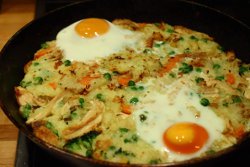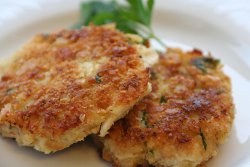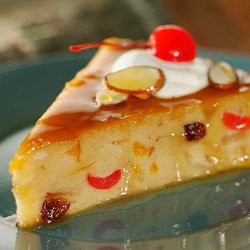 Vampire Weekend's Surprising Jewish Stories
Vampire Weekend's Surprising Jewish Stories


4 min read
3 min read
4 min read
8 min read
Delicious and foolproof recipes that transform your leftovers into a new meal.
If your family is anything like mine, they’re not crazy about leftovers. (And if you’re anything like me, you often misjudge just how much food to cook and find yourself with leftovers very often!)
Here are some foolproof recipes I’ve collected over the years that turn leftovers into creative new meals. They don’t all call for exact measurements – because you never know exactly what you’ll have in your fridge. Feel free to mix, match and experiment – and share your own favorite leftover recipes in the comments section below!
 I first read how to make these delicious pancakes in The New York Times, and they quickly became one of my kids’ favorites.
I first read how to make these delicious pancakes in The New York Times, and they quickly became one of my kids’ favorites.
For the pancakes:
Beat eggs, then add flour and salt. Mix in leftover meat and/or vegetables. Add water or leftover chicken soup, and stir until well blended.
Heat vegetable oil in a nonstick frying pan over medium heat. Using a soup ladle or ½ cup measuring cup, pour batter into pan one spoonfull at a time. Cook until brown and crispy on bottom (about 2 minutes), then flip and fry until brown and crispy on the other side (2 minutes).
For the dipping sauce:
Combine all ingredients in a bowl and serve as an accompaniment to the pancakes.
Serves 4.
This Southern-inspired dish is one of my family’s favorites – and a great way of using up cooked chicken and leftover chicken soup after Shabbos! Please note, all measurements are approximate.
Preheat oven to 350 degrees F.
For the chicken:
Saute the onion, garlic, celery and mushrooms until soft. (If you have other vegetable leftovers such as peas or chopped asparagus, feel free to throw that in too once the onion mixture is cooked.) Sprinkle flour over vegetables and stir to mix. Then stir in chicken pieces and chicken soup. Stir until well mixed, then place chicken mixture in a shallow baking dish.
For the dumplings:
Mix flour, salt, baking powder and margarine together. Gradually add chicken soup until the mixture forms a soft, sticky dough.
Using two spoons, drop spoonfuls of dough onto chicken mixture. Bake, uncovered, 30 minutes, until dumplings are golden brown.
Serves 4.
 Famous French cook Jacques Pepin confides that his family prefers this soup – made with leftover turkey bones and leftover salad greens – to versions calling for fresh ingredients.
Famous French cook Jacques Pepin confides that his family prefers this soup – made with leftover turkey bones and leftover salad greens – to versions calling for fresh ingredients.
Remove all the skin from the turkey carcass. Place all the turkey bones, juice, and cooked garnishes in a large stainless steel stockpot with the water. Bring the water to a strong boil, then skim off and discard as much of the fat and scum from the surface as possible.
Reduce the heat, and boil the mixture gently, uncovered, for 2 hours. Strain. This will yield 2 quarts of stock. (Note: if your yield is greater, boil the stock until it is reduced to 2 quarts; if your yield is less, add water to bring up to 2 quarts.) Remove and discard all visible fat from the surface of the stock. Pick the meat from the bones, and add it to the stock.
Rinse the stockpot, and place the stock back in the pot with all the remaining ingredients except the pastina. Bring the stock to a boil, reduce the heat to low, cover, and boil gently for 20 minutes. Add the pastina, and continue to boil gently, covered, for another 10 minutes. Serve immediately, or cool completely, and refrigerate or freeze for later use.
From Cooking with Claudine by Jacques Pepin (Bay Books, San Francisco: 1996).
 Bubble and Squeak is a classic British recipe using leftover cooked potatoes and cabbage. Celebrity British chef Jamie Oliver has given it a modern twist and made it even more versatile: his recipe calls for any leftover cooked vegetable, not only cabbage.
Bubble and Squeak is a classic British recipe using leftover cooked potatoes and cabbage. Celebrity British chef Jamie Oliver has given it a modern twist and made it even more versatile: his recipe calls for any leftover cooked vegetable, not only cabbage.
Heat olive oil and butter or margarine in a large frying pan over a medium heat. Add the potatoes and vegetables and gently mash them up in the pan. Pat it down into a thick pancake shape and keep frying on a medium heat for about 30 minutes, checking it every 5 minutes or so to make sure the bottom isn’t burning. If it is, then lower the heat and keep watching it. Once the bottom turns golden, carefully flip it over bit by bit and mash it back into itself. Pat it out flat again and continue cooking until really crisp all over.
When the bubble and squeak is nearly ready to come off the heat, start on the eggs. Bring a large pan of salted water to the boil then turn down to a simmer and add the 4 eggs. Remember when it comes to poaching eggs, the fresher the eggs the better the result. Cook for 4 to 5 minutes for a soft to firm egg or a bit longer if you prefer your eggs a little harder.
Serve a slice of the bubble and squeak topped with a seasoned poached egg
Serves 4.
Adapted from www.jamieoliver.com
 8 oz Cooked Salmon
8 oz Cooked SalmonFor the coating and shallow frying:
To garnish:
In a large mixing bowl combine all the ingredients for the fish cakes together thoroughly, then taste and season as required with salt and pepper.
When you’re ready to cook, lightly flour a working surface, turn the fish mixture out onto it and form it into a long roll 2-2 ½ inches (5-6 cm) in diameter. Cut the roll into twelve round fish cakes. Pat each cake into a neat flat shape, and dip each one first into beaten egg and then in the dry white breadcrumbs. Now shallow-fry the cakes in equal quantities of oil and butter or margarine until golden-brown on both sides. Drain on crumpled kitchen paper (paper towel) and serve immediately. If you like you can cook cod or other fish for this recipe – and it is also nice to mash the potato with 1 dessertspoon of mayonnaise.
Serves 4.
Recipe from Delia Smith’s Complete Cookery Course by Delia Smith (BBC Books, London: 1998).
 This fruity, nutty Cuban dessert calls for a stale loaf of Cuban bread – though stale challah loaves can be substituted instead. (If you served your challah during a meat meal, this recipe can be make parve by substituting soy milk for cow’s milk.)
This fruity, nutty Cuban dessert calls for a stale loaf of Cuban bread – though stale challah loaves can be substituted instead. (If you served your challah during a meat meal, this recipe can be make parve by substituting soy milk for cow’s milk.)
Crumble the bread into a large mixing bowl, pour the milk (or soy milk) over it and let stand 1 hour. Meanwhile, have a 2-quart baking dish warming in a 200 degree F oven.
In a small saucepan over medium-high heat, place ½ cup of the sugar, the butter or margarine, and the water. Stir until the mixture begins to bubble and turn a caramel-brown color. Remove the baking dish from the oven and pour hte hot caramel into it. Roll the caramel around the dish to coat the sides. Set aside to cool.
Turn the oven up to 325 degrees F. In another medium-size mixing bowl, beat together the eggs, the remaining 1 ½ cup sugar, and the vanilla. Stir the beaten eggs into the bread mixture. Add the oranges, almonds, and the raisins. Pour the mixture into the prepared baking dish and bake on the middle rack of the oven for 1 hour. Cool slightly before serving, or cover with plastic wrap and chill in the refrigerator before serving.
Adapted from A Taste of Cuba by Linette Creen (Plume, NY: 1994).
